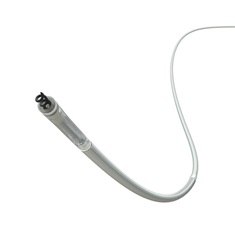
Medtronic has received US Food and Drug Administration (FDA) approval of the OmniaSecure defibrillation lead for placement within the right ventricle. The lead—based on the SelectSecure Model 3830 pacing lead and delivered via catheter—builds on Medtronic’s portfolio of lead solutions designed for precise delivery and placement, as per a company press release.
The lead connects to an implantable defibrillator and is intended to treat potentially life-threatening ventricular tachyarrhythmias (VT), ventricular fibrillation (VF) and bradyarrhythmias. According to Medtronic, as the “world’s smallest” defibrillation lead (4.7Fr [1.6mm]), the OmniaSecure device represents a “meaningful innovation” in electrophysiology, and is indicated for stimulation in the right ventricle for adults and adolescent paediatric patients aged 12 years and above—including those with smaller anatomies.
Medtronic is also studying the placement of the novel, small-diameter OmniaSecure defibrillation lead in the left bundle branch (LBB) area, which has the potential to enable physiologic pacing to more closely mimic the heart’s natural conduction system. Investigational outcomes of this study were presented recently at the 2025 Heart Rhythm Society (HRS) annual meeting (24–27 April, San Diego, USA). Results from the study demonstrate high defibrillation success of 100% at implant when the lead is implanted in the LBB area. Medtronic’s recent release notes that, globally, the OmniaSecure defibrillation lead is investigational for use in the LBB area and requires US FDA approval for this indication in the future.
US FDA approval of OmniaSecure lead
According to the company, existing defibrillation leads—used as standard alongside implantable cardioverter-defibrillators (ICDs) and cardiac resynchronisation therapy defibrillators (CRT-Ds) in the prevention of sudden cardiac death—are larger in diameter than the OmniaSecure lead. A larger-diameter lead may increase the potential for downstream complications, such as venous occlusion or tricuspid valve regurgitation, Medtronic further claims.
“FDA approval for the OmniaSecure defibrillation lead furthers our ability to offer physicians and patients a transvenous solution designed to be smaller to help minimise complications—including vascular complications and valve interaction—with strong, reliable lead durability. We engineered the OmniaSecure lead based on the trusted SelectSecure Model 3830 pacing lead, which has been the lead of choice for many physicians for more than 20 years,” said Alan Cheng, chief medical officer of Medtronic’s cardiac rhythm management business. “This milestone underscores our commitment to driving clinical innovations that help patients today while paving the way for future innovations that will usher in the next era of electrophysiology.”
Previously, researchers presented late-breaking data from the global LEADR pivotal trial showing that the OmniaSecure defibrillation lead met its primary safety and effectiveness endpoints, and exceeded prespecified performance goals, when placed within the right ventricle. The results were delivered during the 2024 HRS meeting, and simultaneously published in the journal Heart Rhythm, and are the basis of US FDA approval for the traditional right ventricular lead placement indication of the device.
Late-breaking LBB pacing results
Researchers presented late-breaking results from the LEADR LBBAP study at this year’s HRS meeting, showing that the OmniaSecure defibrillation lead demonstrated high defibrillation success when placed in the LBB area for patients indicated for an ICD or CRT-D. Placing the defibrillation lead in the LBB area is being evaluated as an alternative to right ventricular stimulation for sensing, pacing, cardioversion and defibrillation.
Defibrillation testing conducted in 162 patients at device implantation was successful in 100% of cases, with the study meeting its prespecified efficacy goal of 88%. Of the first 193 patients implanted in the study, the OmniaSecure lead was successfully implanted per protocol in 95.8% of the procedures as reported by physician investigators. There were no procedure-related major complications, such as early helix or lead fracture, system revision, or death.
“The left bundle branch area is emerging as an option for more physiologic pacing for patients who receive an ICD or CRT-D to treat dangerous heart rhythms,” said Pugazhendhi Vijayaraman (Geisinger Wyoming Valley Medical Center, Wilkes-Barre, USA), who presented LEADR LBBAP data at the 2025 HRS meeting. “The option to place a lead in the left bundle branch area may provide for physiologic pacing by engaging the heart’s natural conduction system. These positive preliminary results for the LEADR LBBAP study are encouraging and highlight the potential versatility of the OmniaSecure defibrillation lead.”
The LEADR LBBAP trial is a global, prospective, non-randomised, multicentre study that has enrolled roughly 300 patients at 24 sites in 11 countries across North America, Europe, Asia and Australia. Patients enrolled in the study indicated for an ICD are being followed out to three months while patients indicated for CRT-D are being followed out to six months post-implantation.








